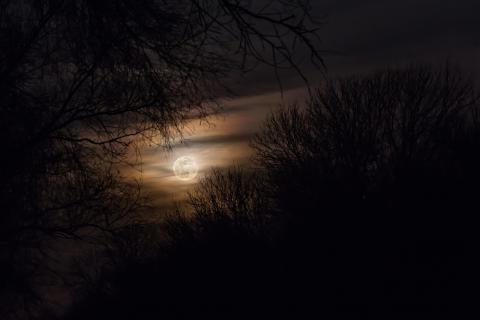Celebrate Dark Sky Week
What does Dark Sky even mean? Have you seen the Milky Way? Clusters of stars so clear that they form a milky cloud in a strip across the sky. I remember looking up in wonder at the night sky in eastern Cape Cod on a summer’s night and being amazed at the clarity of stars that went on and on, and that amazing cloud. But that was many years ago. You need a certain lack of light on the ground to be able to look up and see the stars. Both animals and humans need darkness to aid in body rhythms (such as sleep), navigation (as in migration), hunting, breeding, and other nighttime activities.
Excessive artificial light sources are steadily increasing. This disrupts natural cycles, and is often called “light pollution.” This in turn disturbs those activities, having long-term impacts on human, animal and insect populations.
For sea turtles, lights can discourage females from laying their eggs on beaches or disorient them into going onto roads instead. Turtle hatchlings orient themselves to the light on the horizon to make it to the sea. Artificial lights can disorient them as well, so they do not make it to safety, eventually succumbing to dehydration, exhaustion, and predators.

Migrating birds regularly collide into lit buildings, reducing their numbers. A light can both attract and disorient a bird, causing collisions or steering them off course in migration. In New York City alone, a mecca of lights, about ten thousand birds are hurt or killed by colliding into skyscrapers or high-rise buildings annually. Light pollution can affect frog reproduction cycles, bat feeding behaviors and nocturnal animal hunting. Anyone who has had a porch light on at night in the summer knows what it does to moths and other insects.
Humans themselves are regulated by a circadian clock, the 24-hour day and night cycle. Disruptions in this cycle can affect many aspects of the body, including brain wave patterns, hormone production, and cell regulation. These disruptions can lead to depression, insomnia or sleep disorders, cardiovascular disease, and more. We use artificial lights in our homes to light up the night, and outside lights can affect the amount of indoor light in our rooms when we finally say goodnight. Additionally, blue light from phone and television screens has been shown to have detrimental effects on humans. So maybe it’s time for a little darkness.
It is estimated that about 99% of Americans live in a place where they cannot see the Milky Way. This is due to the “sky glow” caused by artificial light scattered by water droplets or particles in the air. You know that hazy brown, yellow or even red light that seems to hover over a city at night? We have come to accept that as normal. In 1994, when an earthquake knocked out the power in Los Angeles, “many anxious residents called local emergency centers to report seeing a strange, ‘giant, silvery cloud’ in the dark sky. What they were really seeing – for the first time – was the Milky Way, long obliterated by the urban sky glow” (Chepesiuk, 2009, para 1).

We can help introduce more people to the importance of reducing light pollution by taking note of Dark Sky Week. International Dark Sky Week, started in 2003 by Jennifer Barlow and advocated by DarkSky International, is “a worldwide event that draws attention to light pollution, promotes simple solutions to mitigate the issue, and celebrates the irreplaceable beauty of a natural night.” (Dark Sky International, International Dark Sky Week, para 1).
You can celebrate Dark Sky Week by getting together with family and friends and going outside at night. A mountain biking group in Nashua, NH plans a bike ride in the winter darkness (with small headlamps) in a local park! You can visit a designated Dark Sky Park, which has an exceptional or distinguished quality of starry nights and a nocturnal environment that is specifically protected for its scientific, natural or educational value, its cultural heritage, or public enjoyment. Basically, it’s a great place to go to look at the stars without any sky glow. The closest designated Dark Sky Park to New Hampshire is the AMC Maine Woods Park in Maine, but you may know of a spot, as I did on the Cape, that still offers that dark skies view.

You can also educate others about light pollution and the importance of dark skies. In your own neighborhood, you can do a home lighting assessment and adjust the lighting on your property, and advocate for your town to update its lighting policies. According to the National Park Service, 50% of light from an unshielded light fixture is wasted, shining upward where it is not needed. Flood lights are often overkill, and when shining horizontally cause glare. A simple light shield may be a beginning solution, focusing light only where it is needed. According to Tenzie Pugh, superintendent at the McDonald Observatory, “Night sky friendly lights save energy, cost less to operate, improve visibility and safety, and minimize the harmful effects of artificial light on plants and animals, they’re a win-win solution” (Brooklyn, 2021, para 16).
Become a citizen scientist and report on what you can see in your own night sky. You can report your sightings to Globe at Night, which has a goal of 20,000 observations in 2025. What stars can you see in the dark sky?
Dark Skies isn’t just about seeing the stars for yourself, it is also about preserving the natural rhythms of our planet and the many species living within it, including our own. Join the dark side and help celebrate Dark Skies Week!

References and Resources:
Chepesiuk R. (2009). Missing the dark: health effects of light pollution. Environmental health perspectives, 117(1), A20–A27. https://doi.org/10.1289/ehp.117-a20.
Brooklyn, C. (2021, July). Dark Sky Tourism Is On the Rise Across the U.S. National Geographic. https://www.nationalgeographic.com/travel/article/dark-sky-tourism-is-o…
https://darksky.org/
https://darksky.org/what-we-do/events/dark-sky-week/
https://drive.google.com/file/d/1dMGDy44h-kWARk69ZZ166-QFGhGUcA9F/view?…
https://darksky.org/get-involved/home-lighting-assessment/
https://www.outdoors.org/amc-maine-woods-international-dark-sky-park/

